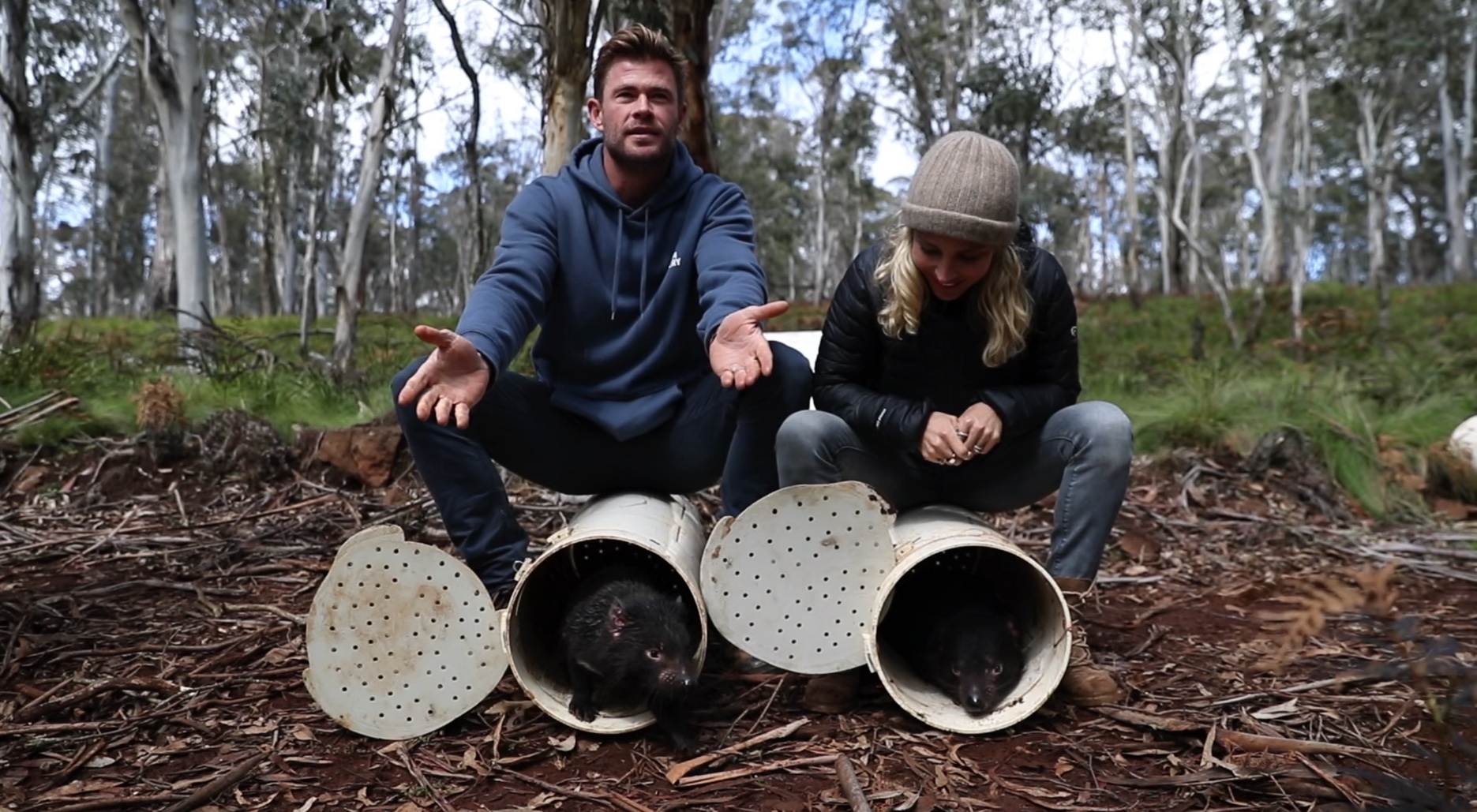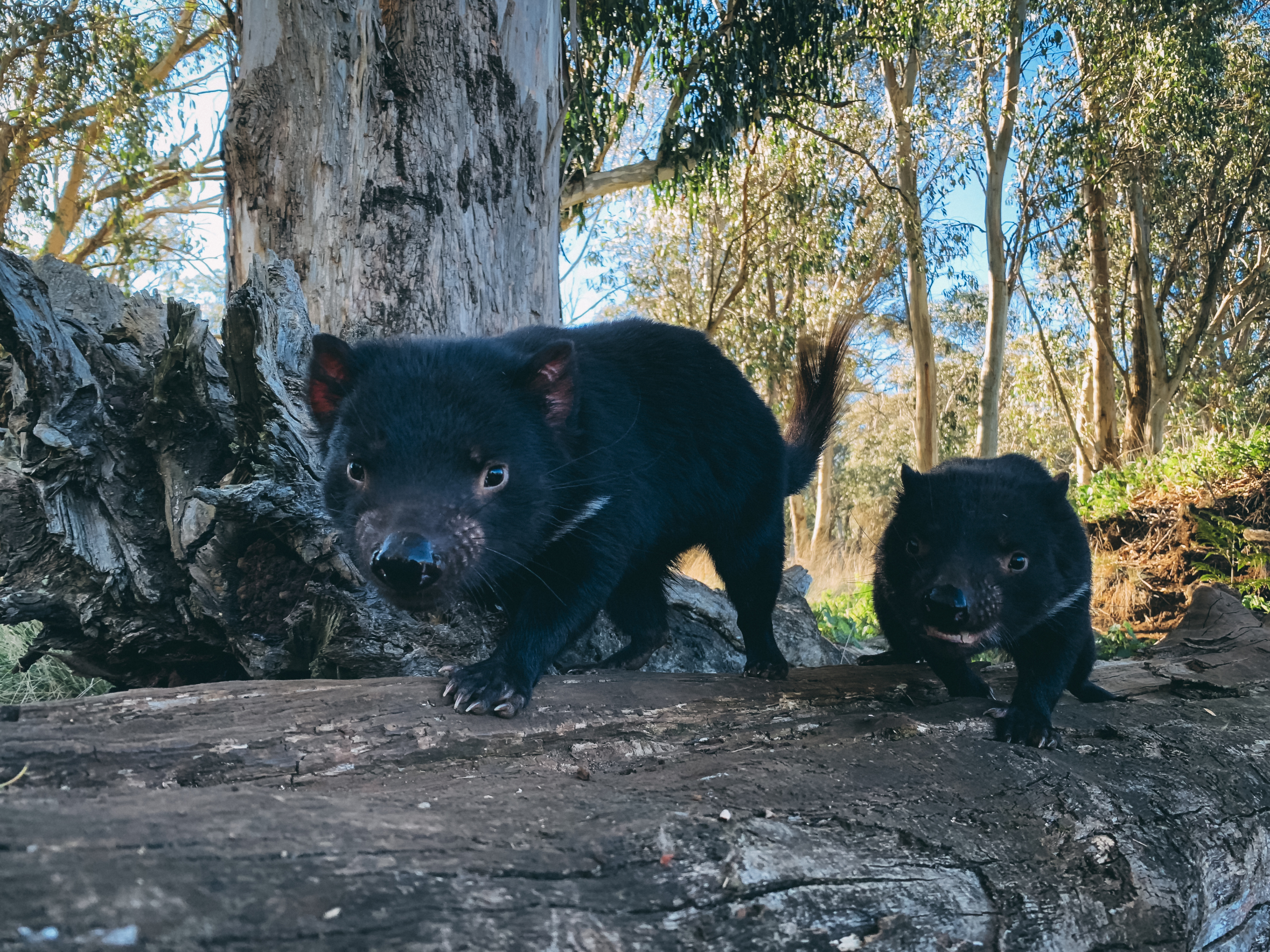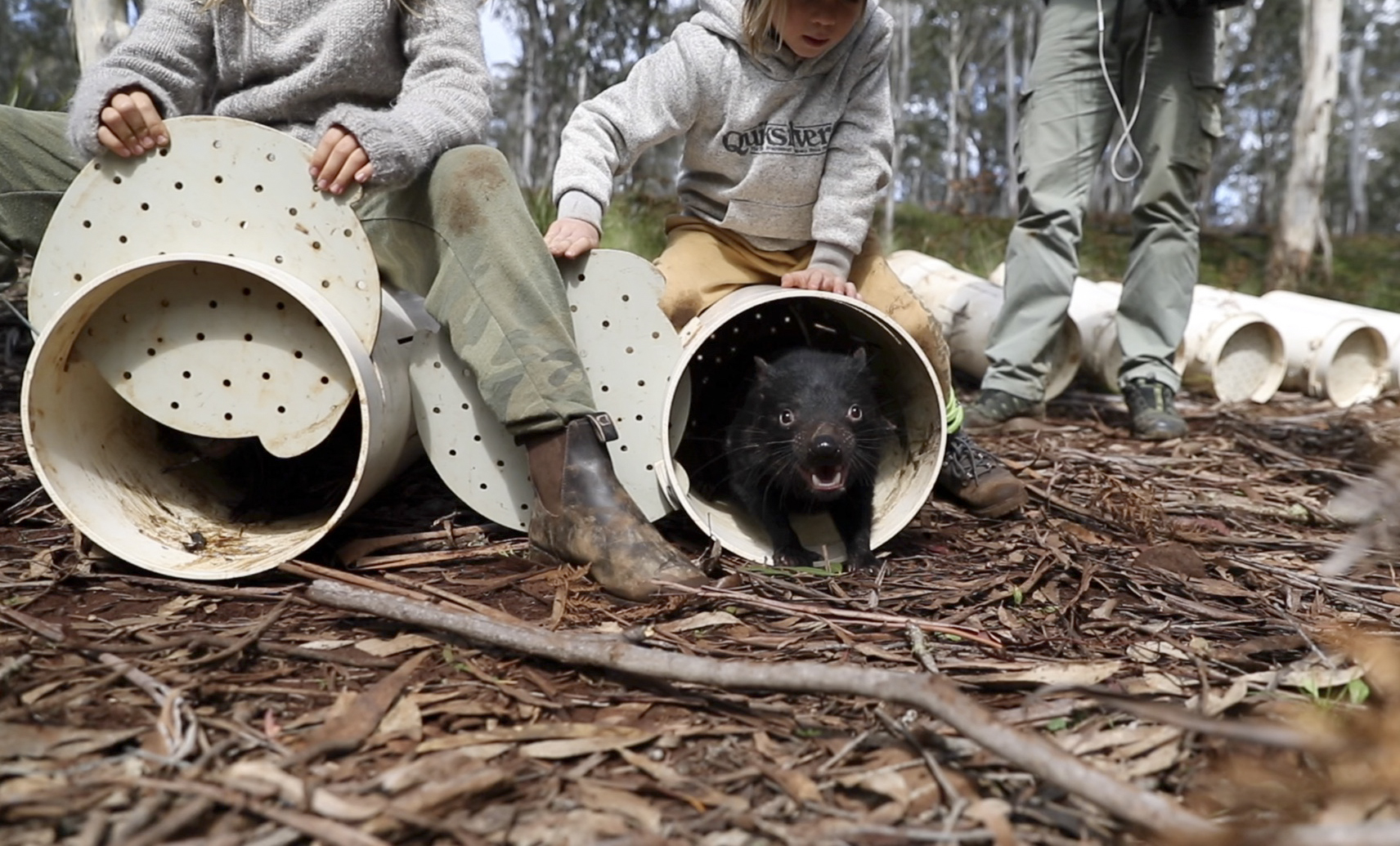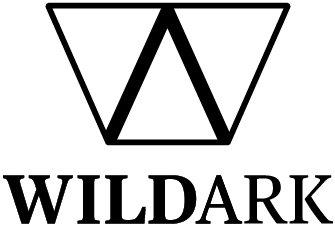Tasmanian Devil beauty shot. Photo:© Aussie Ark
For the first time in 3,000 years, the Tasmanian devil is back in the wild on mainland Australia, a historic moment that is critical to rewild Australia, the country with the world’s worst mammal extinction rate. Aussie Ark, in partnership with Global Wildlife Conservation and WildArk, recently released 11 Tasmanian devils into a 400-hectare (nearly 1,000 acres) wildlife sanctuary on Barrington Tops. Actors Elsa Pataky and Chris Hemsworth, friends of WildArk, helped release some of the animals—including Lenny and Lisa—into their new home.
“In 100 years, we are going to be looking back at this day as the day that set in motion the ecological restoration of an entire country,” said Tim Faulkner, president of Aussie Ark, which has been working with Tasmanian devils for more than 10 years with the goal of someday returning them to the wild. “Not only is this the reintroduction of one of Australia’s beloved animals, but of an animal that will engineer the entire environment around it, restoring and rebalancing our forest ecology after centuries of devastation from introduced foxes and cats and other invasive predators. Because of this reintroduction and all of the hard work leading up to it, someday we will see Tasmanian devils living throughout the great eastern forests as they did 3,000 years ago.”
Tasmanian devils vanished entirely from mainland Australia in large part because they were outcompeted by introduced dingoes, which hunt in packs. Dingoes never made it to Tasmania, but across the island state, a transmissible, painful and fatal disease called Devil Facial Tumor Disease (DFTD)—the only known contagious cancer—decimated up to 90 percent of the wild population of Tasmanian devils. Just 25,000 devils are left in the wild of Tasmania today.
For the last decade, the Aussie Ark team has been building an insurance population of Tasmanian devils and learning everything they can about the animals, including about their reproductive physiology, behavior, and ecological needs, all leading up to the reintroduction, which took place on September 10 and followed a successful assisted trial release with 15 Tasmanian devils. Twenty-six total devils now call the wild of mainland Australia home.
Aussie Ark selected the particular devils for reintroduction based on those most suitable to breed with one another without any inbreeding. The wild sanctuary will prevent the spread of disease, feral pests, noxious weeds and fire, which was catastrophic earlier this year for the country. The wild sanctuary will also keep cars out, ensuring that the devils learn not to associate cars with food—an association that could be deadly when they are more widely released.

Actors Chris Hemsworth and Elsa Pataky help release Tasmanian Devils into the wild on mainland Australia. Photo: © WildArk
Aussie Ark’s Tasmanian devil breeding program is the most successful conservation breeding facility for the endangered species on mainland Australia. Aussie Ark founded a Tasmanian devil breeding program in 2011 with 44 individuals. Today, it’s home to more than 200, which is about 50 percent of the entire captive insurance population spread across mainland Australia. Over the years, more than 390 devils have been born and raised at Aussie Ark in a way that encourages and fosters their natural behaviors, helping ensure that they maintain all the skills they need to survive in the wild.
“Without Aussie Ark’s incredible work and perseverance over all of these years, the recent devil reintroduction would not have been possible and instead of looking forward to the recovery of the species, we would be watching the devil slip into extinction,” said Don Church, president of Global Wildlife Conservation. “This is an incredible example of how to rewild our planet, bringing back the natural systems to the benefit of all life on Earth.”

Tasmanian Devil Lisa, the adventurous one. Photo: © Aussie Ark
Not only does the reintroduction bode well for the recovery of the Tasmanian devil, but as native apex predators and the world’s largest carnivorous marsupials, the animals help control feral cats and foxes that threaten other endangered and endemic species. And because they are scavengers, they help keep their home clean and free of disease. The Tasmanian devil is one of seven cornerstone species critical to Australia’s ecosystem that Aussie Ark plans to reintroduce to the wild sanctuary in the coming years, all chosen to help restore the natural balance: Eastern quoll, Brush-tail rock wallabies, Rufous bettong, long-nosed potoroo, parma wallabies and southern brown bandicoots.
“The re-introduction of devils to mainland Australia is a game-changer for conservation in this country, not only building a robust, genetically healthy population outside of Tasmania, but also paving the way for future introductions that the Aussie Ark team are already mapping out,” said Mark Hutchinson, co-founder of WildArk. “Having partnered with Aussie Ark and GWC on the Koala Comeback Campaign after the bushfires this year, we’ve witnessed first-hand their commitment to ecological restoration in Eastern Australia and we couldn’t be prouder to now support the Devil Comeback. The groundwork is being laid for a broad, nationwide effort to rewild Australia and help our little critters find their niche again.”
This is the first of three planned reintroductions. In the next two years, Aussie Ark will do two additional releases of 20 devils each. The animals will be monitored through regular surveys, radio collars fit with transmitters, and camera traps. This will give the researchers the opportunity to learn about how the devils are faring, where they are claiming territory, what challenges they are facing, what they are eating, and whether they’re reproducing. All of this information will help to inform future releases, including in Tasmania and elsewhere on the mainland, to continually refine the process.

Releasing Tassie Devils into the wild on mainland Australia. Photo: © WildArk
The devastating fires across Australia’s eastern seaboard earlier this year burned more than 72,000 square miles of forest and claimed the lives of at least 34 people and nearly 3 billion animals.
“The fires earlier this year were absolutely devastating and threatened to rob us of our hope,” Faulkner said. “This is our response to that threat of despair: come what may, ultimately we will not be deterred in our efforts to put an end to extinction and to rewild Australia.”
Learn more about this historic achievement today, Monday, Oct. 5, at 7 p.m. ET, when UN Environment Goodwill Ambassador, actor, entrepreneur and Lonely Whale co-founder Adrian Grenier interviews Aussie Ark president Tim Faulkner live on Instagram. Grenier visited Aussie Ark in 2017 to help release 20 Tasmanian devils into 64-hectare semi-wild fenced sanctuaries. Tune in via Aussie Ark’s Instagram page or Grenier’s Instagram page.
In addition, Global Wildlife Conservation, Aussie Ark and WildArk are calling on kids ages 5-to-10 years old around the world to submit digital postcards to any of four of the featured Tasmanian devils released into the wild sanctuary. Kids interested in sending a digital postcard can write to adventurous Lisa, timid Lenny, hangry Skittles, or sassy Jacksen. Thirty of the most creative postcards will be chosen to be published in an e-book. Learn more here.
Aussie Ark’s partners include Global Wildlife Conservation, WildArk, Glencore, Australian Geographic, Australian Reptile Park, WIRES and FAME.
To support visit devilcomeback.org.
